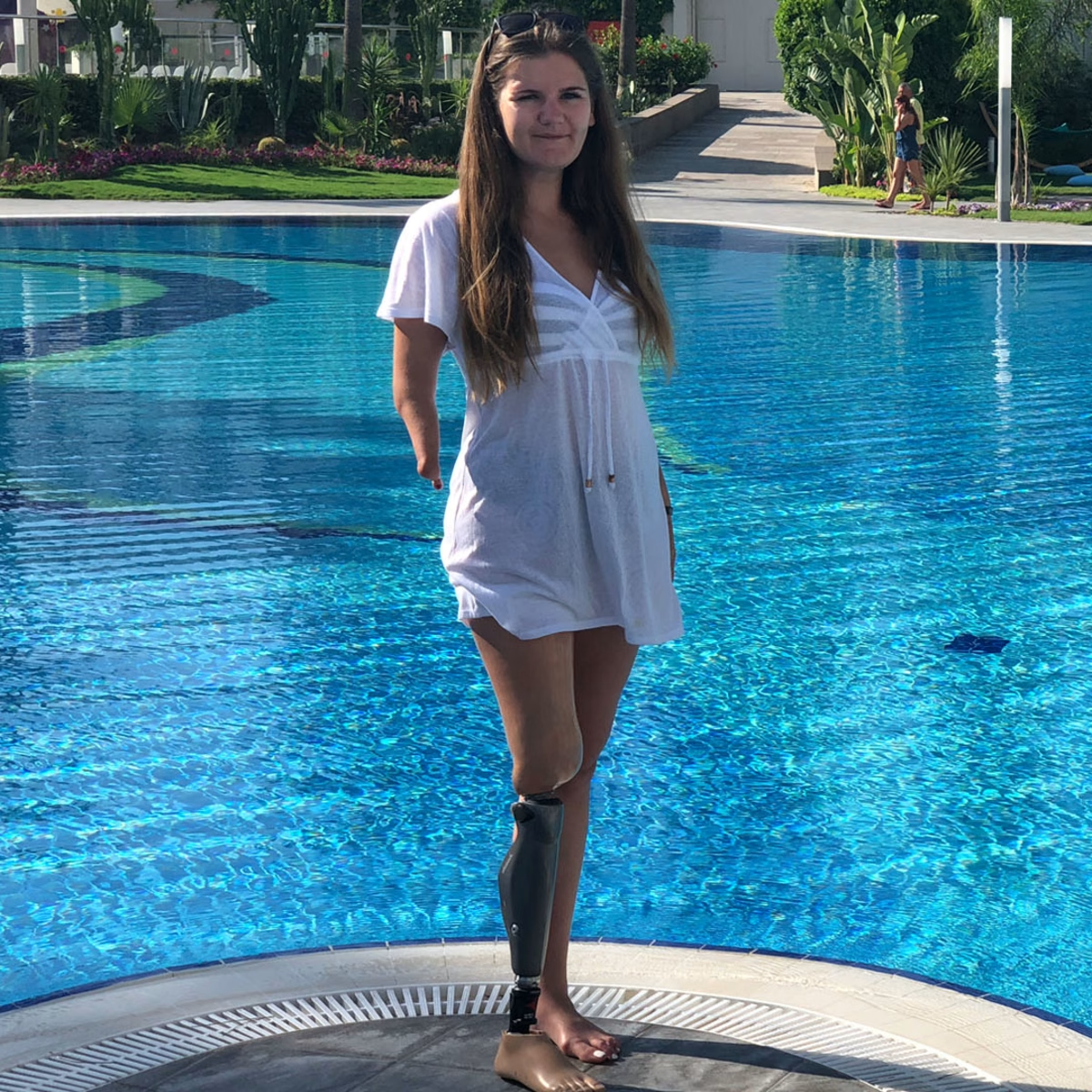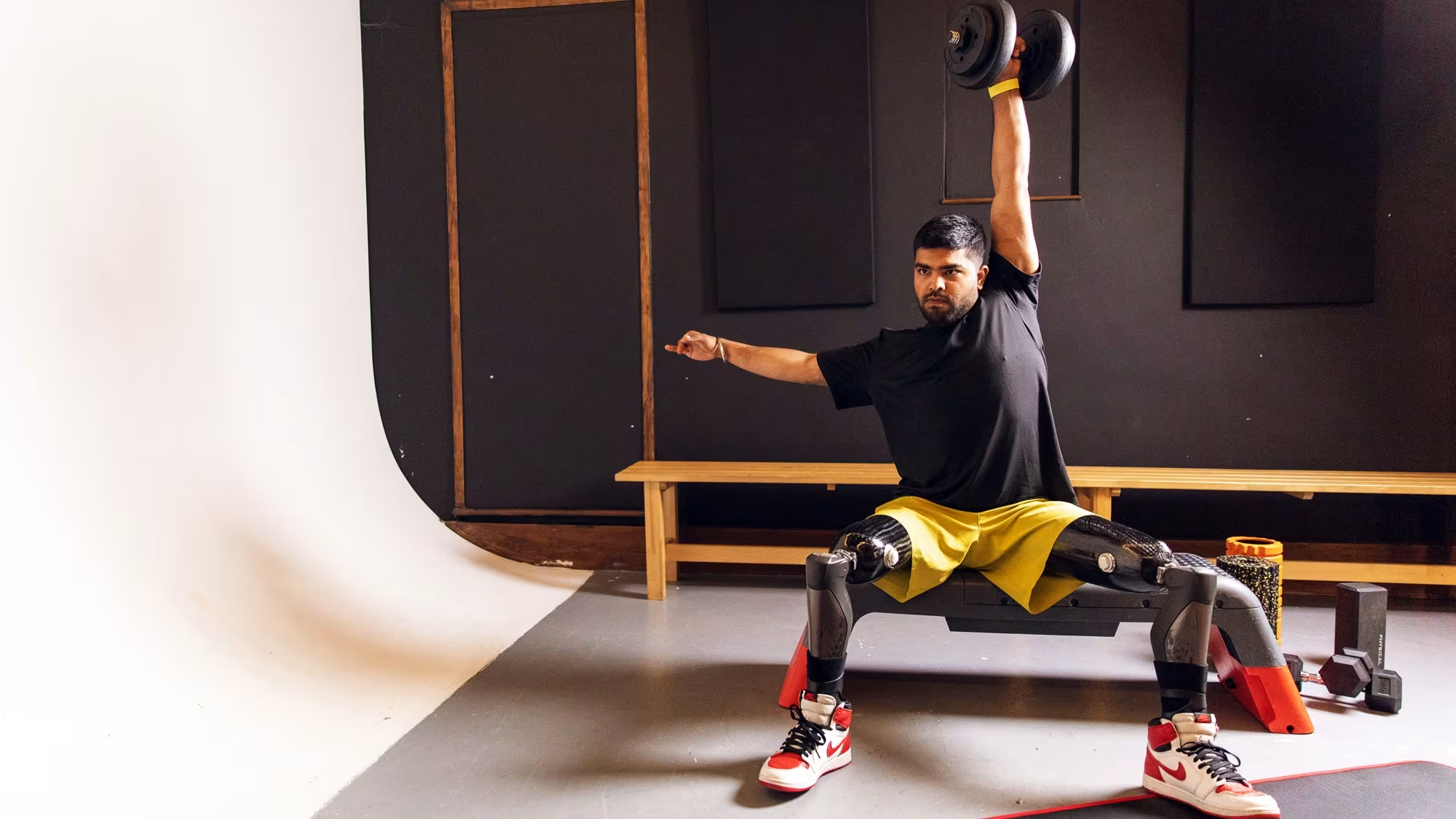


Steph's C-Leg Story
Drama Student Steph now enjoys a more enriched and active lifestyle thanks to NHS Microprocessor Knee Policy
26 year old Steph Dimmock from Hull is a drama graduate, merchandiser and television/film extra. A congenital amputee, Steph’s fiercely independent spirit led her to pursue an exciting and sociable life in London, where she received her first advanced computerised prosthetic leg in 2017. Steph explains what it’s like to grow up as a young amputee, the drama lessons that gave her confidence and how her new knee has helped her to do more than even her ambitious nature ever thought possible.
Steph was born missing her right hand, with her right leg twisted and tucked under her left leg. “It wouldn’t straighten and it was six inches shorter than my left leg when I was born. I was also born with a deformed left hand. The doctors tried for years to straighten my right leg but even then it wasn’t fully working; it only had four toes, it was thin at the end and I couldn’t put weight on it at all so I was never able to walk on it” explains Steph. After several procedures, medics told her parents that they could keep trying but that there would be no guarantee that further treatments could offer her any greater quality of life than she already had. Steph adds, “The other option was to amputate my leg, and I knew that it could actually give me more options when it came to walking.”
The family made the tough decision to have Steph’s right leg amputated when she was just nine years old. “I was home within three days of the amputation; I’ve never been one to mess around and I don’t like hospitals. Even at the age of nine I was head-strong and knew I wanted to be at home. I still remember the journey home in the car with my parents, I’ll never forget it,” says Steph.
She got her first prosthetic leg within three months, saying, “I had never been able to walk properly before so this was a completely new experience for me. I remember getting it and I had to go back to school on the same day. All the kids were waiting around the corner and they were all excited to see me finally walk.”
Steph used a mechanical prosthesis with a basic knee joint throughout her childhood and teenage years, before getting the C-Leg 4 at the age of 26. She says, “I managed during school with this mechanical leg even though it wasn’t the most stable or reliable; it’s always been a part of my personality that nothing can stop me. If I want to do something then I will find a way to do it.” She rode her first bike with this mechanical knee at the age of 13.
After finishing her GCSEs Steph was ready for the next step, and she went on to study performing arts at college. “I’ve always been a drama queen,” says Steph “I love theatre, I think it gave me a confidence that I never had before, or at least that I didn’t know I had. Like most teenagers, you go through changes that make you feel less confident about your body but as an amputee I found it harder. Not only did I feel conscious of my body but also about wearing a prosthetic leg. People would stare and I felt really different. It would affect me. Now I am a completely different person but back then I found it really difficult. I even stopped going swimming, which I had enjoyed so much as a kid, because I had to take the prosthesis off and people would look at me. I think drama helped me to build the confidence that I had lost. I used to go to theatre groups and I found them to be an outlet from any problems I faced at school.”
At just 18 years old, Steph felt ready to fly the nest and leave the comforts of home behind to start a new life at university. She studied social work; “I thought it would be perfect for me because I like helping people and working with charities” she says, “but I realised that it wasn’t the right path for me.” Unfortunately some health issues meant that she was unable to complete her first year at university. During her recuperation, independent Steph also realised that Hull was a little too close to home, despite living in university halls. “I realised that I wanted to branch out a bit further and pursue drama” she says. She applied to Greenwich University when she was 19 years old and moved down to the capital three months later, adding “I loved London so much I never wanted to leave; I got a job here and have made it my home.”
She studied drama for three years at Greenwich university, making the most of student life and even getting involved with stand-up comedy, speaking about her experiences of living with a disability. “I found it difficult at first being in London with my prosthetic leg because in my home town I never had to walk very far and I wasn’t used to the physical activity, it was a big adaption for me. Now that I have the C-Leg 4 I can’t quite believe that I used to get around everywhere on my mechanical knee; everything used to feel a lot harder.”
Steph graduated with strong results in her degree and she got her first job within three months of finishing university, working on the shop floor in M&Ms World, London, before changing roles to become a merchandiser for the store. In addition to her regular job, Steph is an extra for film and television, having appeared in films such as The Mummy and The Foreigner, plus adverts for brands including Morrison’s.
When asked about the transition over from a mechanical knee to a C-Leg 4 in 2017, Steph says; “I lived my entire life from age nine to 26 with a mechanical knee but I knew that there would be other, better options out there for me.” She adds, “When my prosthetist told me about everything these microprocessor controlled knees can do, I was so excited. He explained that they are more stable, could help me to walk better and be more independent.”
Steph initially trialled two types of Microprocessor Knee, starting with the C-Leg 4. “Within the first few steps I felt safer than I have ever felt before on a prosthetic leg. It felt like a completely different way of walking. Even in the first six weeks I was able to walk further and quicker than I had before and without using my crutch as much.”
For Steph the most remarkable change was the way in which she was now able to tackle stairs; “I’ve never ever been able to go up and down stairs properly,” she says “I never bent my knee. I used to have to bring it around so it would take a long time to get up or down just a few steps. With the C-Leg, at first it was challenging to have the faith that I could walk down the stairs, something so simple was completely alien to me. But when I first started to understand how to walk step-over-step down the stairs, it was a massive thing for me. It was transformational. Being able to walk up and down stairs opened up a lot of doors on the underground because there are a lot of staircases and before this I could only take certain routes, so it would take me much longer to get to places. Once I got more confident using the C-Leg, I could choose which way I wanted to go.”
She adds that the C-Leg gave her the ability to safely walk up and down slopes or hills; “The yielding feature on the C-Leg gave me control over it when going down steep hills. There’s a very steep hill near to home which I was terrified of previously and wouldn’t have dreamed of taking on even with someone’s support. With the C-Leg I wasn’t afraid and I managed to walk down the hill, even stopping if I wanted to. This gave me confidence because I felt stable and knew I wasn’t going to fall. I was in control of it rather than it being in control of me. I could set my own pace.”
Six months on from receiving her C-Leg, Steph has started to enjoy new activities and higher confidence levels, saying, “I’ve just started in the gym because I want to be stronger. With my previous leg I didn’t feel comfortable going to the gym; it was a trust thing and the leg just didn’t feel stable enough. I was having endless falls so I didn’t even attempt it.” She adds; “The C-Leg has enabled me to do a leg press, and I have been building up strength in new areas of my legs. I am also using the treadmill, which is exciting and I am walking faster than I ever could have walked before.” Steph hopes that one day she might be able to work with other amputees to share fitness and workout tips.
Steph loves music and enjoys concerts, and the C-Leg has even helped her to experience the best of London’s nightlife and culture. At a recent gig at the O2 she decided to book some seats on the lower tier, instead of going for the wheelchair seats as she would previously have done. She says; “I knew it was going to be busy and that there would be around 50 steps I would have to climb. I feel so much more confident so I just decided to go for it. Before, if somebody would have knocked me or touched me slightly I would have fallen over but with the C-Leg I knew that if anything happened I can hold my balance better. And I had a fantastic night!”
Steph describes herself as a social butterfly who loves to go out with friends and travel. “I drive so I like going to new places. I like exploring” she says. Steph has plans to travel to Turkey with her family this summer, and in 2019 hopes to go away to the United States with her friends. “I am really looking forward to going abroad with this leg; I think it’ll be much easier to walk on the sand, so it’s a lot more convenient for me.”
Not only does Steph credit her C-Leg with giving her the confidence to exercise and try new things, she also says that it has given a boost to her self-esteem; “Even though I’m not a self-conscious teenager anymore, I would still sometimes avoid wearing shorts or dresses because of the way my old mechanical knee looked and other peoples’ reactions. Since I got the C-Leg I’ve been showing it off, because it looks sporty to me. I wear cropped leggings, trainers and I show it off all the time. I am feeling a lot more confident out and about which I wouldn’t have ever dreamt of before.”
Discover the Kenevo and C-Leg 4
Trust, evolve and thrive with Ottobock.
Ottobock has been proudly providing the C-Leg 4 to medium - highly active individuals through the NHS since 2016. More recently less active individuals or those beginning their rehabilitation journey have been fitted with the Kenevo. Our signature Microprocessor Knee (MPK), C-Leg 4 offers lower limb amputees the technology and performance to live the life they want while the Kenevo aids amputees in improving their mobility and gaining independence. Keep reading to learn more about these solutions and the process of being fitted with an MPK through NHS funding.

